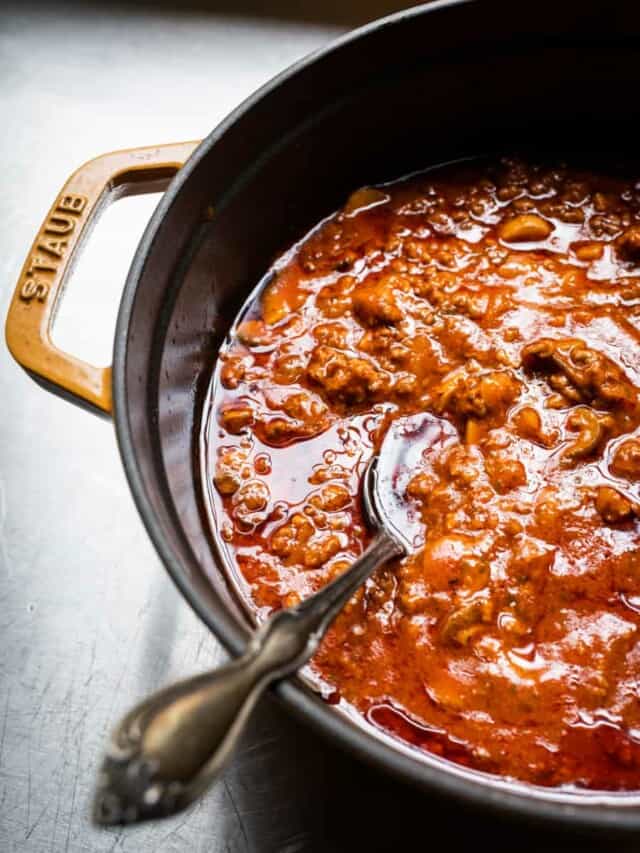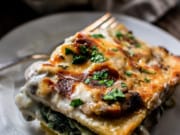Fresh Gluten-Free Pasta is absolutely doable. We're certain you can do this....and we're totally certain you should! Give fresh pasta a try! This fresh pasta recipe from Alison Needham is the best one we've found found cutting with a pasta machine. If you want to make lasagna sheets or hand-cut noodles, check out this recipe instead.
Recipe and article courtesy of Alison Needham, A Girl Defloured

Making fresh pasta had become a lovely weekend ritual that my husband and I participated in with some frequency in the years before my diagnosis. He turned the hand crank while I held the dough as it passed through the machine. We’d chat and sip wine, mellow music playing softly in the background. As the pasta rested, I whipped up a sauce or topping with whatever fresh vegetables I’d picked up at the Sunday farmers’ market. It was a wonderful time, and a supper that everyone in the family looked forward to.
Figuring out fresh gluten-free pasta:
When I found out I was a celiac, all of that came to a halt. I knew that I could probably make a fairly good gluten-free fresh pasta. However, it would require a new machine (my old one was most certainly contaminated with gluten) and lots of patience as I tested out recipes. Last weekend, we went out and purchased a new machine and made our first attempts. The dough started out very crumbly and dry (we live in a very dry climate), so I added more eggs. Although it was moist enough to come into a ball, it crumbled when we passed it through the machine. I tried adding more xanthan gum. A lot more. I’m not a huge fan of “gums” but they are necessary to achieve the proper texture and elasticity in gluten free pasta.
The pasta made it through the roller without falling apart, though the edges were a bit more ragged than I was used to. I was a little worried that it wouldn’t survive the cutting but it held together quite nicely. I draped the strands over the backs of my chairs and counters to let it rest. Later that evening, I boiled the pasta in lightly salted water and tossed it with a rich red sauce. I tentatively took my first bites. I was so relieved that the texture and flavor were exactly like I remembered–amazing!

Why you should make fresh gluten-free pasta:
There really is no comparison for fresh gluten-free pasta. Making pasta is a little like making love. The first few times it feels a little clumsy and awkward. Once you get the hang of it (with the right partner) it’s an easy, fun (and dare I say pleasurable) way to spend the afternoon. Ahem.
Do I need to add xanthan gum to my gluten-free pasta dough?
You don't need to add more xanthan gum to the pasta dough if the blend you are using already contains it. However, you can add gum-free binder if you find the dough it isn't holding together well with the flour blend you are using. This recipe would use about 2 teaspoons of gum-free baking binder. Pamela's Gluten-Free Artisan Blend or King Arthur Measure for Measure flours both work well in this recipe.

Want Fresh Gluten-Free Lasagna Sheets or Hand-cut Noodles? We can help.
This recipe for gluten-free lasagna sheets is next-level delicious. It's the recipe you want if you don't have a past machine or if you'd like to make hand-cut noodles.

Gluten-Free Fresh Pasta for Pasta Machines
Equipment
- pasta machine
Ingredients
- 3 Cups gluten-free all-purpose flour blend
- 1 teaspoon sea salt
- 4 teaspoons xanthan gum (omit if your flour blend contains it)
- 5-6 extra large eggs lightly beaten
Instructions
- Pulse flour, salt and xanthan gum (if adding) in the bowl of a food processor fitted with the steel blade attachment to combine.
- Add 5 eggs, one by one, pulsing after each, until thoroughly combined. If dough is still crumbly, add one additional egg. Dough should be smooth and only slightly tacky to the touch.
- Turn dough out onto a board that is lightly dusted with sweet rice flour. Knead dough until it comes together in a relatively smooth ball. Cut dough into four equal parts, and cover with a damp cloth so it stays moist.
- Cut the first portion of dough into thirds and flatten each part with the palms of your hands. Set your pasta machine (either hand crank or attached to a mixer) on the largest setting (usually 6). Lightly dust the first portion of pressed dough with more rice flour and pass it through the machine, fold it into thirds and pass it through again. Set it aside on a clean dishcloth. Continue in this manner with the rest of the dough..
- Turn the pasta machine down a notch to number 5. Pass each portion of dough through the machine again, gently laying them out on the dishcloth. Make sure you start with the dough you rolled out first and follow the same order each time.
- Turn the pasta machine down another notch to number 4 and pass the dough through again in the same manner.
- Turn the machine down to 3 and repeat.
- At this point, the pasta will probably be all over your kitchen counters. These noodles can be cut by hand into lasagna, or fettuccine shapes, or you can cut the pasta with your machine. To do that, switch out the pasta press for the pasta cutter. I prefer the linguine or spaghetti cutter. Starting with the first pasta rolled, gently pass the pasta through the cutter, catching it with your hands as it comes out. Some of the edges will be shorter in length, and that's okay. Gently lay the longer strands across the back of a chair, on a pasta rack, or on a lightly floured surface. Continue with the rest of the pasta in the same way. Pasta can be used within a couple of hours, or refrigerated in a sealed container and used within a day or two.
- To cook: Boil the pasta for 2-3 minutes in lightly salted water. Continually taste for doneness. Toss with any sauce you desire.
Notes
Nutrition

Meat Sauce: the start of everything good.
Every Italian family has a sauce recipe that they claim is the best - this is our family's Meat Sauce. You be the judge.

Now that you've got Meat Sauce, let's talk Homemade Lasagna.
Once your gluten-free pasta is ready to go, you can tackle my mom's fabulous homemade lasagna recipe.








Esther Urrutia says
What is ap flour? are there any other types of gluten free flours I can use for pasta? please help. thank you
K.C. Cornwell says
Hi Esther - "AP" stand for All-Purpose, so you're looking for an all-purpose/cup-for-cup gluten-free blend. The one I use most often is Pamela's All-Purpose Artisan Flour Blend in the dark blue bag. KC
Eleanor says
if we use GF flour with xanthan gum in it already do i still need to add the xanthan gum listed in recipe?
Mother Caring says
This recipe had so much XG in it, I couldn't eat it. I'd say the answer is no.
K.C. Cornwell says
HI there! You don't need to add more xanthan if you blend already contains it - sounds like you did and I'm sure that was WAY too much - thanks for letting us know, we updated some of the recipe text to clarify that.
If you make this recipe and you find it isn't holding together well with the flour you are using, you could add 2 teaspoons of gum-free baking binder: https://gfreefoodie.com/how-to-make-gum-free-baking-binder-and-using-xanthan-guar-gum-in-gluten-free-baking/
If you are sensitive to gums, that binder could help with your other recipes too.
K.C. Cornwell says
HI Eleanor - if your blend already contains xanthan gum or a binder, you don't need to add more. If you make this recipe and you find it isn't holding together well with the flour you are using, you could add 2 teaspoons of gum-free baking binder: https://gfreefoodie.com/how-to-make-gum-free-baking-binder-and-using-xanthan-guar-gum-in-gluten-free-baking/